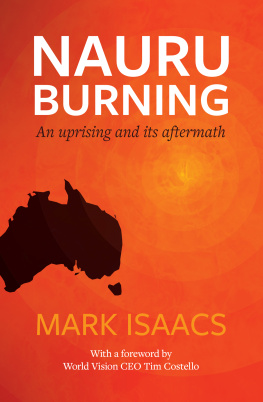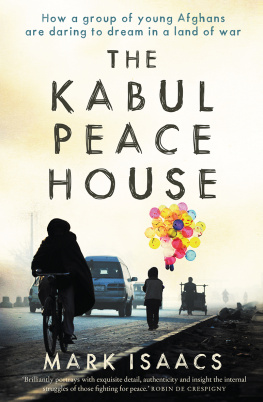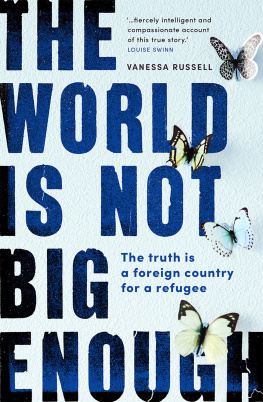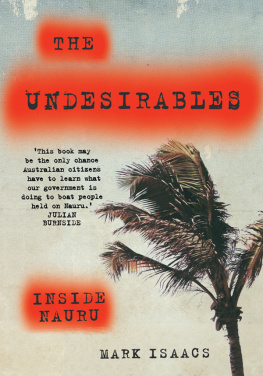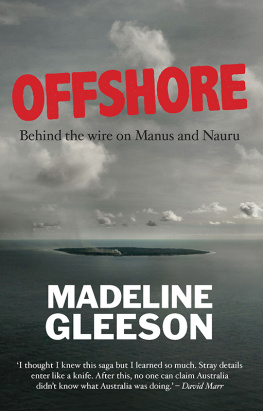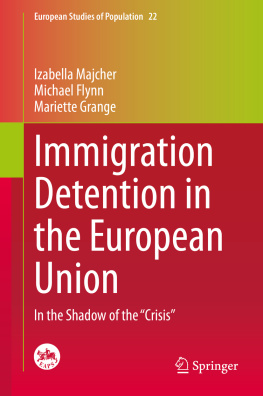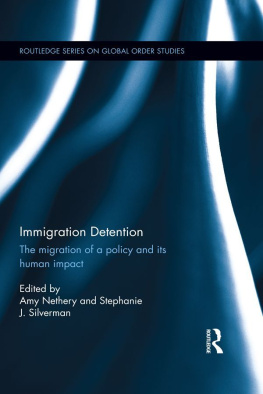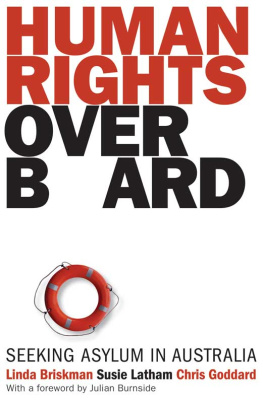NAURU BURNING
Baqir wanted to die there; he wanted to stop living. Everything he had ever suffered and lived before was in front of his eyes. His bright future was destroyed.
He said to the security guards: If you think someone was involved in this incident you can punish them, put them in jail, put everyone you think is guilty in jail, but stop doing it like this: dont punish everyone.
On 19 July 2013, a serious incident, a riot, occurred at the Nauru Regional Processing Centre. Fires destroyed most of the centre, causing more than $60 million in damage. More than 150 men were arrested. Only two men were convicted for incidents relating to the unrest. These convictions were overturned on appeal.
This is the story of how the tinderbox ignited and of the consequent investigation into who was responsible for the fire. It is the story of the men in detentions fight to prove their innocence, and of the workers who tried to help them. Ultimately, it is a comment on the lack of accountability and oversight for service providers within the deliberately remote and closed environment of Australias offshore detention centres.
Nauru Burning is another dark chapter in Australias shameful treatment of people asking for our protection.
Contents
The riot by asylum seekers on the remote island of Nauru in July 2013 probably meant very little at the time to most Australians.
Nauru, after all, was thousands of kilometres away from Australian eyes. Turmoil involving a group of boat people on one of the smallest islands and poorest nations in the Pacific region was of little immediate concern.
The media ran for a while with the story of rioting refugees and the $60 million damage bill to our offshore detention centre with little explanation of why the trouble had erupted.
Mark Isaacs insight into the events that led up to the riot and fire at the Nauru refugee detention centre, and its aftermath, should concern every Australian. This book is graphic evidence of dark practices directly linked to Australias immigration and border protection policies.
He reveals that the riot was the inevitable culmination of months of growing tensions, fed by an overwhelming sense of despair and uncertainty experienced by the detainees who demonstrated against a system they deemed unjust.
He also details the shoddy organisation by some of those in charge on Nauru, the subsequent inconclusive investigation into the riot which resulted in further abuses of human rights and, in the end, a lack of accountability by authorities.
It is a shameful story that needed to be told. Mark Isaacs has rightly taken a stand against a policy of secrecy and lack of scrutiny that may have hidden the truth forever.
His is not a view from afar. It is an insiders story.
Mark worked as a Salvation Army volunteer on Nauru soon after the Pacific Solution was reintroduced in 2012 and witnessed first-hand the oppressive conditions faced by asylum seekers those vulnerable souls who are supposed to be under our care but have too often become people deprived of hope.
The refugees had fled their homelands to escape persecution and violence. And yet they found themselves locked in an immigration process, supposedly on safe shores, that sometimes proved even worse than the troubles from which they were originally escaping.
It was an explosive situation with inevitable consequences.
What happened on Nauru points to a question for all of us: is Australia a generous nation committed to giving all people a fair go? Or is it an inward-looking nation blind to the suffering and needs of vulnerable human beings from a different culture?
Australians are known as a fair-minded and generous people. As CEO of World Vision, I have been privileged to see many Australians support our efforts to eradicate poverty and respond to humanitarian crises. I cannot forget the overwhelming Australian generosity that was generated in the wake of the Asian tsunami.
What is happening in our name on offshore detention centres is not worthy of us. We are better than that.
I have said before that indefinite detention of asylum seekers in offshore detention centres is psychological torture. It is unconscionable.
In their determination to stop the boats, successive Australian governments have cast refugees into a no-mans land of indefinite detention, out of sight, out of mind and out of conscience.
We all need to stand up to show that Australia is a nation that is willing to reach out to those in need. We need to stand up when we are informed of abuses to vulnerable people. We need to re-evaluate how we treat asylum seekers.
I commend Mark Isaacs for bringing this story into the light. I hope it inspires change.
Tim Costello
Melbourne, June 2016
On 19 July 2013 a serious incident, a riot, occurred at the Nauru Regional Processing Centre (Nauru RPC) resulting in the destruction of the majority of infrastructure. There were 543 transferees accommodated at the Nauru RPC at the time of the incident. It is estimated that the loss and damage from the incident was in excess of $A60 million.
Riots are anarchic expressions of discontent, often the last resort of the silenced and oppressed. A riot within a deliberately remote and closed environment such as an offshore detention centre is particularly difficult to dissect. Accounts are personal, often biased, often conflicting. Accounts by officialdom are much more likely to be publicised than those by people detained or working within the system. First-hand accounts are hard to come by. People are scared to speak out. People seeking asylum in Australia dont want to be branded as troublemakers. Australians working in the detention system are worried about their jobs, their careers, and about the potential repercussions of whistle-blowing.
I was asked to write about the July 2013 riot by a former colleague who had been working in Nauru at the time: he was horrified by what happened that night and the way the men were treated in the aftermath. He wanted someone to bring the story to the public arena but was too worried by the possible repercussions to speak out. After hearing his insider account I had many questions.
What causes people in immigration detention centres to riot? How are protesters treated in the aftermath of such an incident? Who will conduct the investigation into the protest? How are the rights of the accused upheld? How can we monitor this procedure? If I hadnt followed this story, would we ever have found out what happened to these men, or were their stories destined to be swept into some dark and filthy corner of an offshore processing centre along with all the other secrets the Government is trying to hide from us? Have we learned anything at all from the July 2013 riot?
The story of people in Australian detention centres rising up against their oppressors is not new. It is one that reappears in our newspapers and then fades away like an echo. Nauru, April 2016, and the acts of self-immolation by Omid and Hodin; Christmas Island, November 2015, and the death of Fazel Chegeni; Manus Island, February 2014, and the death of Reza Berati; the Villawood fires in April 2011; the Curtin riot, 2002; and the numerous protests in Woomera, in 2000, 2001, and 2002; just to name a few. At what point do we stop blaming the people detained in these centres and start questioning the system?
I felt compelled to follow this story; a story that has become especially pertinent in light of the Moss inquiry findings(DIBP) will go to cover up human rights abuses. This story is another dark chapter in our countrys treatment of people seeking protection. This is the story behind a riot.
Mark Isaacs
Sydney, September 2016
K Hamburger, 8 November 2013, Nauru Review 2013 Executive Report of the Review into the 19 July 2013 Incident at the Nauru Regional Processing Centre
Next page
